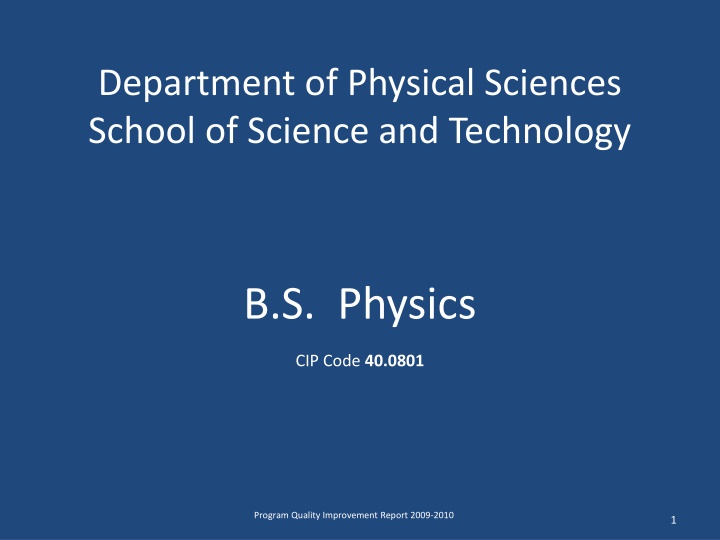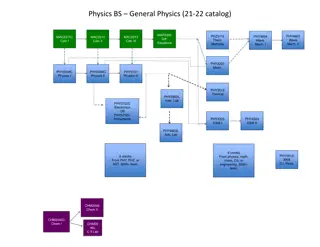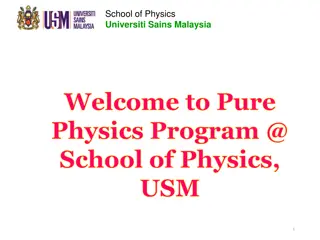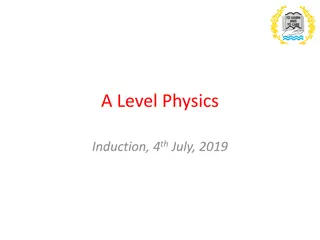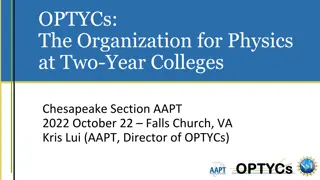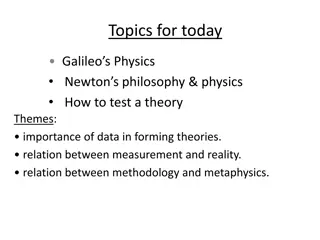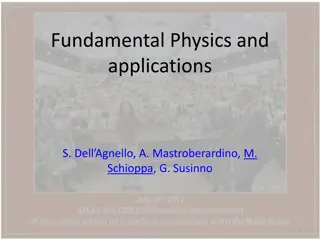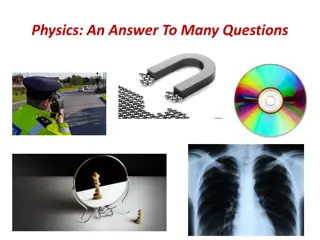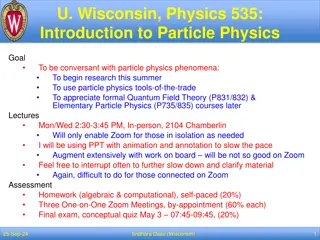Student-Learning and Program Objectives in Physics Curriculum
In the Physics program, students develop critical evaluation, presentation, and collaborative skills. Specific objectives cover areas such as quantum mechanics, thermodynamics, electricity, and modern physics. The curriculum aims to prepare students for technical roles in industry, advanced studies in physics, or teaching science education.
Download Presentation

Please find below an Image/Link to download the presentation.
The content on the website is provided AS IS for your information and personal use only. It may not be sold, licensed, or shared on other websites without obtaining consent from the author.If you encounter any issues during the download, it is possible that the publisher has removed the file from their server.
You are allowed to download the files provided on this website for personal or commercial use, subject to the condition that they are used lawfully. All files are the property of their respective owners.
The content on the website is provided AS IS for your information and personal use only. It may not be sold, licensed, or shared on other websites without obtaining consent from the author.
E N D
Presentation Transcript
Department of Physical Sciences School of Science and Technology B.S. Physics CIP Code 40.0801 Program Quality Improvement Report 2009-2010 1
Student-Learning or Service Outcomes General objectives. Generally, the program is designed to do one of the following: Provide preparation sufficient for entry into a technical position in industry Provide preparation sufficient for entry into graduate programs in physics Provide preparation for the discipline portion of teacher education for Science education Provide support for other baccalaureate programs which need a strong background in physics From consideration of these specific paths, a set of general objectives can be identified which are fairly typical of virtually any degree program in the University. The student should be able to: Critically evaluate new unfamiliar material and draw conclusions Orally present technical information with appropriate conclusions and recommendations Present in a variety of writing styles technical information and recommendations Work collaboratively with a group to attack an issue 2 Program Quality Improvement Report 2009-2010
2.- Specific content driven objectives. In addition to these more general objectives, a set of basic content-related objectives have been identified and are listed in the table that follows. The table also gives the course(s) in which the student may be expected to encounter the specific objectives and the area of the Major Field Achievement Test which addresses the objective. The parenthetical numbers in the MFAT column indicate the relative abundance of questions in each area. The set of content objectives listed for the program are those typically expected of students planning to attend graduate school. Though they align fairly closely with the MFAT exam, the driving force for determining the objectives is the informed view of the physics faculty as to the subjects that are most essential. In the list we include an indication of the level of knowledge expected to be reached following Bloom s taxonomy: K: Knowledge C: Comprehension Ap: Application An: Analysis S: Synthesis E: Evaluation Program Quality Improvement Report 2009-2010 3
Specific Program Objectives General Group Specific Objective Course(s) that cover this material: MFAT Section Electrical Measurement and Electronics (3024) Introduction to quatum mechanics (3043) Heat and theromodynamics (3403) Electricity and Magnetism (4113) Modern Physics I LAB (3011) Physics II (1215 or 2025) Modern Physics I (3003) Physics I (1115 or 2015) Mechanics (3303) Light (4403) Classical Mechanics scalars and vectors mass and weight velocity acceleration force linear and angular momenturm work energy power and frames of reference Newton's Laws of Motion conservation of energy and momenturm special relativity time dilation length contraction addition of velocities Doppler Effect E=mc2 Heat and Thermodynamics concepts of heat temperature entropy heat transfer thermodynamic processes and cycles Quantum Mechanics experimental evidence of quantization: black body radiation Millikan oil drop experiment heat capacity of solids photoelectric effect Compton Effect Frank-Hertz experiment Stern-Gerlach experiment, Zeeman effect theoretical development of quantum mechanics: wave function and its interpretation Schroedinger equation Momentum in Q.M. Harmonic oscillator in Q.M. particle in a box hydrogen atom symmetries angular momentum in Q.M. Electromagnetism Coulomb's Law Gauss' Law Ampere's Law Maxwell's equations concepts of electric and magnetic fields and potentials properties of electromagnetic waves circuit analysis Kirchhoff's rules Thevenin's theorem Norton's theorem Light and Optics Ray optics Reflection / Mirrors Refraction / Lenses Dispersion Interference / diffraction / gratings An Ap Ap Ap Ap Ap An An Ap An An An An An An An An An An An An An Section I (19%) Section I (19%) Section I (19%) Section I (19%) Section I (19%) Section I (19%) Section I (19%) Section I (19%) Section I (19%) Section I (19%) Section I (19%) An S An S An An An An An Section I (19%) Section I (19%) Section I (19%) Section I (19%) Section I (19%) Ap Ap Ap Ap Ap An An An S S Section III (18 %) Section III (18 %) Section III (18 %) Section III (18 %) Section III (18 %) Ap Ap Ap Ap Ap Ap Ap Section IV (23%) Section IV (23%) Section IV (23%) Section IV (23%) Section IV (23%) Section IV (23%) Section IV (23%) S S K K C Ap Ap Ap Ap Ap Ap An An Section IV (23%) Section IV (23%) Section IV (23%) Section IV (23%) Section IV (23%) Section IV (23%) Section IV (23%) Section IV (23%) Ap Ap Ap Ap Ap C Ap Ap Ap Ap An An An An An An Section II (17%) Section II (17%) Section II (17%) Section II (17%) Section II (17%) Section II (17%) Ap An An An Section II (17%) Section II (17%) Section II (17%) Ap Ap Ap Ap Ap S An An An S Program Quality Improvement Report 2009-2010 4
Alignment of Outcomes A. Alignment with Cameron University s Mission Statement: The program objectives and learning outcomes align with the Cameron University s mission statement as follows: The physics program at Cameron University is designed to provide physics majors an environment of academic freedom that will guarantee the dissemination of knowledge and the appreciation of physics and in solving real world application problems. There is a strong positive alignment of the learning outcomes with all three component missions (University, School of Science and Technology and Department of Physical Sciences). This alignment optimizes the goals from the mission statement which are in accord with our program objectives. The program objectives and learning outcomes are designed to provide physics majors with a strong foundation of physics for acquiring knowledge, skills, and attitudes for a lifetime of learning. Students who graduate with a physics degree can pursue a plan of graduate study or pursue advanced studies in a health career or obtain a career in industry requiring general laboratory skills and working with chemicals. These highly skilled graduates will be able to promote our physics program and eventually attract more qualified students to our program. 5 Program Quality Improvement Report 2009-2010
B. Alignment with School of Science and Technology s Mission Statement: The learning outcomes and program objectives provide students with a strong knowledge base and quantitative skills. Students are able to explore physics, gaining useful skills as well as an appreciation for the subject. Some of our students participate in internships in industry and graduate schools where they can apply their physics skills to real world situations. Department graduates are equipped to pursue a career in physics or graduate studies. C. Alignment with Department of Physical Sciences Mission Statement: The department objectives and learning outcomes are strongly aligned with the department mission statement. The content has been carefully selected to provide both majors and non-majors with the physics knowledge and skills needed to excel in their desired academic program and to gain an appreciation for the power and versatility of physics. In addition, the physics program provided by the department gives majors a rich physics knowledge base that adequately prepares them for graduate work or a career in teaching or industry. D. Alignment with Cameron University s Strategic Plan The program objectives and learning outcomes relate to Cameron University s strategic plan as follows: The program objectives and learning outcomes are designed to provide our students with the tools necessary for them to successfully compete in the job market both today and into the future. This is achieved by promoting a familiarity with present technologies, the ability to communicate physics effectively, and an overall solid foundation in physics. In the past students also had the opportunity to interact with the community via internships with local companies. The interaction with the community is a key point in the Cameron Strategic Plan. Program Quality Improvement Report 2009-2010 6
Measures of Learning and Service Outcomes MFAT results Embedded questions in final exams of physics courses. 7 Program Quality Improvement Report 2009-2010
Report on actions from the three previously chosen priority outcomes Physics I: It is the course where we have the best assessment measures. The new data for this report includes the fall of 09, and the summer of 2010. Some of the areas of concern have been improved and we are going to focus on other areas starting in the spring (pending the results from the fall of 2010). 8 8 Program Quality Improvement Report 2009-2010
Physics II: We are glad that in four areas the average of the class has stayed above the initial comparison values; The performance in problems about electric field and charge stays weak in spite of efforts to improve. We are now going to apply a more distributed analysis of how the students attack those problems. In the action plan we address this concern. Quantum Mechanics: Base on the initial results our students will need to improve in the area of angular momentum, while keeping their good performance in the other four areas assessed. Program Quality Improvement Report 2009-2010 9
Student-learning or service outcome and measurements (Use a separate chart for each priority outcome) MEASUREMENTS OF STUDENT LEARNING OR SERVICE OUTCOME Methods used to determine validity of measurement instruments Methods used to determine reliability of measurements CURRICULUM AREA OR TARGET AUDIENCE PROGRAM OUTCOME Schedule for measurements Measurements Example: IT 4444, IT 4342 List measurements and identify each as direct or indirect* Example: Norm-referenced scores Example: Inter-rater reliability Example: Annually , Fall Semester Example: Upper division math courses Example: Locally developed test (direct) Example: alumni, employer, and student surveys (indirect) Data is shown in the next few slides trying to adhere to the chart shown as an example.( A slightly different version is used). 10 10 Program Quality Improvement Report 2009-2010
Display of assessment data MFAT results from May 2010 This year we have three graduates that took the MFAT in physics. For comparison we also present the data from the last two years: By Student Data May-08 By Class Data Introductory physics Sub Score 1 36 Advanced physics Sub Score 2 55 Mean Percent correct 36 17 50 63 72 Total Score % 145 Student Student 1 % 20 % 60 Topics % 5 1 85 90 60 Classical Mechanics and Relativity Electromagnetism Optics/Waves and Thermodynamics Quantum Mechanics and Atomic Physics Special Topics 40 May-09 Introductory physics Sub Score 1 21 44 37 39 Advanced physics Sub Score 2 34 37 25 40 Mean Percent correct 23 44 25 31 25 Total Score % 126 141 124 139 Student Student 1 Student 2 Student 3* Student 4 % 1 40 25 25 % 20 20 1 25 Topics % 1 40 1 10 1 Classical Mechanics and Relativity Electromagnetism Optics/Waves and Thermodynamics Quantum Mechanics and Atomic Physics Special Topics 1 30 1 25 Average 132.5 14 35.25 34 23 16.5 * natural science major, concentration in physics May-10 Introductory physics Sub Score 1 42 31 52 Advanced physics Sub Score 2 28 28 76 Mean Percent correct 36 36 47 38 36 Total Score % 135 129 165 Student Student 1 Student 2 Student 3 % 35 10 55 % 5 5 90 Topics % 5 15 75 15 40 Classical Mechanics and Relativity Electromagnetism Optics/Waves and Thermodynamics Quantum Mechanics and Atomic Physics Special Topics 15 5 80 Average 143 41.7 44 33 33 33.333333 11 Program Quality Improvement Report 2009-2010
Embedded questions in Optics Spring 10 4403 8 students P+ 42 45 26 53 42 36 82 1 Diffraction Resolution 2 Polarization 3 Interference 4 Double slits 5 Total internal reflection 6 Photon energy 7 Blackbody Radiation 87.5 62.5 75.0 25.0 100.0 62.5 75.0 46.6 69.6 Mean In the spring of 2010 we gathered data from embedded questions in the course Light and Optics for the first time. Trends will be developed in the future based on this initial set of scores. As in the case of Quantum Mechanics we can compare these results to national averages for similar problems in GRE exams. Program Quality Improvement Report 2009-2010 12
Embedded questions in physics II Fall07 1215 9 Fall 08 1215 12 Spring 09 1215 29 Fall 09 1215 10 Spring 10 1215 27 Spring 09 2025 6 students P+ 46 55 50 27 40 GRE MFT1 MFT2 MFT3 MFT4 177 Problem 17 10 9 12 12 Temperature and kinetic theory Electric field / charge DC circuits Induction / Faraday s law Light: Geometric optics 66.6 37.2 75.0 44.0 53.4 66.7 0.0 58.3 33.3 41.7 48.3 6.9 65.5 31.0 65.5 90.0 20.0 10.0 30.0 30.0 70.4 18.5 55.6 14.8 70.4 50.0 33.3 66.7 33.3 100.0 Program Quality Improvement Report 2009-2010 13
Embedded questions in final exams of physics courses. As we have been doing in the last few years we include certain standard questions in the final exam of our physics courses. These questions are in the style of the MFAT. These are selected questions to keep track of the progress in key areas of the physics program. In the tables below, we show the number of students that took the exam, the semester when the test was administered, the topic that the question covered and a comparison with published results in similar GRE questions. The published results are shown as P+ in the tables and as a green line in the figures. The trend figures that accompany the tables indicate the progress that the results have followed. The x-axis corresponds to the time when the test was administered. In the case of Physics I and II, we distinguish between the algebra based classes (blue lines and marks) and the calculus based (larger red marks and lines). All the data shown contain new results from the past academic year. We also have new data from Introduction to Quantum Mechanics and Light and Optics. The data from these two new courses are initial data that will be used in the future for trend analysis. Embedded questions in physics I Sp 08 Sum 08 Fall 08 Sp 09 Sum 09 Fall 09 Sum 10 1115 1115 1115 1115 32 15 36 22 Fall 08 2015 9 1115 16 1115 29 1115 22 number of students GRE Problem 177 177 177 177 9677 P+ 62 54 50 30 28 4 23 50 26 30 68.8 12.5 62.5 53.1 43.8 60 20 80.6 30.6 66.7 36.1 30.6 68.0 14.0 68.0 45.0 32.0 75.0 12.5 68.8 25.0 43.8 62.1 27.6 79.3 41.4 32.1 81.8 54.5 86.4 54.5 59.1 88.9 11.1 55.6 88.9 55.6 Momentum and Energy Conservation in collisions. Circular Motion and Addition of vectors. Sound Waves, Resonance Conservation of Mechanical Energy and Rotational Motion. Hydrostatic Pressure, density. 53.33 60 40 Program Quality Improvement Report 2009-2010 14
Embedded questions in Modern Physics I Fall 08 3003 9 Fall 09 3003 9 students P+ 53 52 49 60 52 Relativity: Velocity addition Line spectra: Hydrogen Blackbody Photoelectric Effect X-ray production 77.8 66.7 88.9 77.8 22.2 100.0 66.7 100.0 100.0 44.4 53.2 66.7 82.2 Mean Program Quality Improvement Report 2009-2010 15
Embedded questions in Quantum Mechanics Spring 10 3043 students 4 63 75 100 100 25 75 Eigenvalues Normalization Linear Momentum Angular Momentum Hermitian Operators 50 82 75.0 Mean In the case of the data from quantum mechanics we only have one initial data point, so no trend analysis is possible yet, however the results can be compared to similar national results of similar questions in GRE exams. Judging by the results it can be concluded that we need to improve in the areas of Angular momentum and Hermitian operators. Program Quality Improvement Report 2009-2010 16
Analysis of assessment data 1. Please observe the multi year trend chart attached to each of the previous tables. Notice that we can only have multi-year trends when there are multi-year data. Outcomes that have only one data point show the data only on a table. Comparison are made with similar national responses from standard tests. When possible, comparisons are also made with previous Cameron students data. 2. 3. 17 Program Quality Improvement Report 2009-2010
Action plan for Student-Learning or Service Outcomes - In Physics I several initial areas that were of our concern are now consistently performing very well, so a new set of areas for focusing will be defined pending data from the fall 2010 semester. - Knowledge of angular momentum that represented one of the weak areas in previous assessment of physics I has improved, but the results from quantum mechanics indicate that the weakness has to be addressed again in its quantum mechanical counterpart. Modern Physics and Classical Mechanics emphasis in this area could help resolve this issue. - The laboratory of Physics II should receive the same update of Physics I and new experiments or additional activities for calculus based physics students should be implemented. We will judge the results by looking at their performance in embedded questions in the final exams. 18 Program Quality Improvement Report 2009-2010
Published information on graduates Entered Graduate School Working In Discipline Other Academic Year 09-10 Summer 2009 1 Fall 2009 3 Spring 2010 4 Total 19 Program Quality Improvement Report 2009-2010
